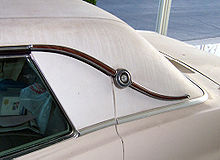| Revision as of 07:33, 27 July 2004 editMorven (talk | contribs)Autopatrolled18,655 editsm Picture of a landau bar.← Previous edit | Revision as of 08:16, 1 August 2004 edit undoMorven (talk | contribs)Autopatrolled18,655 editsm simulatedNext edit → | ||
| Line 1: | Line 1: | ||
| A '''landau''' (named after ]) is a ] term for a specific ]. It originated in the ]-drawn ] days, and referred to a four-seat open-top carriage with folding ] tops on both ends that could completely cover the passengers. The center section might contain a fixed full-height door, or a low door. There would be a separate driver's seat, normally uncovered. | A '''landau''' (named after ]) is a ] term for a specific ]. It originated in the ]-drawn ] days, and referred to a four-seat open-top carriage with folding ] tops on both ends that could completely cover the passengers. The center section might contain a fixed full-height door, or a low door. There would be a separate driver's seat, normally uncovered. | ||
| ]]] | ]]] | ||
| A distinguishing characteristic of the landau was the external hinged supporting bars mounted on the outside of the folding top. When the top was up, these bars would form an elegant shallow 'S' shape. The bars are variously known as ''landau bars'', ''landau bows'', ''landau irons'' or ''S-bars''. | A distinguishing characteristic of the landau was the external hinged supporting bars mounted on the outside of the folding top. When the top was up, these bars would form an elegant shallow 'S' shape. The bars are variously known as ''landau bars'', ''landau bows'', ''landau irons'' or ''S-bars''. | ||
Revision as of 08:16, 1 August 2004
A landau (named after the German city) is a coachbuilding term for a specific body style. It originated in the horse-drawn carriage days, and referred to a four-seat open-top carriage with folding convertible tops on both ends that could completely cover the passengers. The center section might contain a fixed full-height door, or a low door. There would be a separate driver's seat, normally uncovered.

A distinguishing characteristic of the landau was the external hinged supporting bars mounted on the outside of the folding top. When the top was up, these bars would form an elegant shallow 'S' shape. The bars are variously known as landau bars, landau bows, landau irons or S-bars.
Many coachbuilding terms transferred over to automobile usage, since coachbuilders began making motor car bodies instead, and because customers were familiar with coachbuilding terms. The landau, however, was not a style that transferred well to the automobile. A forward view was generally insisted upon by passengers, and so the half-landau landaulet style, instead of the landau, became a more popular choice. The landaulet opens over the rear seats, but not the front. Some of these vehicles were inaccurately described as 'landaus'.
In the 1920s and 1930s, especially in the United States, the term 'landau' became used for a simulated convertible, in which a fixed roof of a sedan with solid rear quarters was covered with fabric or leather and fitted with side landau bars in order to appear like a convertible top. This became the commonly accepted definition of 'landau' in North American usage thereafter.
Postwar, the term fell into disuse, only to be revived during the 1960s as the trend for such 'fake convertibles' with vinyl roofs established itself. Some of these vehicles were called 'landaus' by their manufacturers, and many were fitted with landau bars on the rear quarters. Some use the term 'Town Landau', and this generally means a wider rear pillar with no rear quarter windows, or a vinyl roof that only covers the rear seat area (and is thus reminiscent of a town car).
A landau roof is also commonly used on the North American hearse; very long closed rear quarters, a vinyl roof and huge, polished landau bars have been the preferred hearse style since before World War II.
Category: